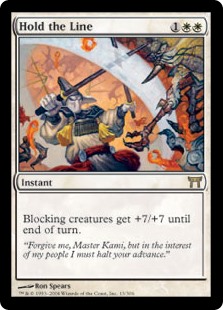There is a classic adage that you’ve undoubtedly heard a hundred times by now: the best defense is a good offense. Although the phrase was originally attributed to warfare and military tactics, over the years it has been adapted to myriad topics, from economics, to business, to sports. The logic states that the best way to stave off the encroachment of your enemy is to not be put in a disadvantageous position to begin with. If you’re aggressive against your competition from the start, it puts you in a much better position to fortify your position should you do have to fall back. And if you can dominate your opponent from the start, that’s even better.
(Also, in case you ever wondered if history was dictated primarily by men, look no further than this concept in action.)
This also applies to the world of Magic: the Gathering. This is a game where – most of the time – the last person standing is the winner. The powers that be want you to be aggressive. They want you to focus on being on offense as much as possible. They desire Magic to be one of consistent combat and speedy rounds. The modern philosophy of Magic’s design team is that it should primarily be fast, brutal, and short.
They want games to be competitive and interesting, but over the years they’ve taken active efforts to discourage gameplay styles that slow the game down. Creatures are more likely to have enter the battlefield triggers than activated abilities. Cards like Walls, damage prevention, and Fog effects are seen in smaller percentages than in the earlier years. And the power level of Blue cards that focus on bouncing or other forms of control are heavily monitored in terms of their power levels. Essentially, Wizards has been actively curtailing cards that have the potential to slow the tempo of the game down. They much prefer players win through conquest than by entrenching themselves as to set up longer and more complicated ways to win, such as life loss or alternative win conditions.
WotC has even tacitly admitted as much. The reasons as to why vary (most point to the timed round restrictions of tournament play as the primary factor), but the fact remains that you’re not imaging things if you noticed this trend.
Of course, that adage is not universal. In sports like hockey and soccer, for instance, the phrase is famously reversed, demonstrating that a solid defense can instead be the key to victory. It also happens to be very true in multiplayer Magic. And there are tools to aid you in such enterprising. Fireballs can be overcome with protection and lifegain, for example. Board wipes can be handled with indestructibility and regeneration. And a Overrun-infused attack can be met on the battlefield with this week’s pick.
Today we have: Hold the Line

Name: Hold the Line
Edition: Champions of Kamigawa / Speed Vs. Cunning
Rarity: Rare
Focus: Creature Buff / Combat Control
Highlights: White has always been a combat-centric color. Since the beginning White has had combat tricks at the ready, from straight up damage prevention, to creature destruction, to a host of cards that allow it to do things during the heat of battle that the color doesn’t have access to otherwise (such as direct damage). Hold the Line is part of the lattermost category, whereby you are able to provide a substantial temporary buff to your creatures – at least, if you’re blocking.
Hold the Line was the inevitable evolution of many similar ‘buff on blocking’ White cards from the game’s past, mixing the explosive defensive potential of Righteousness with the widespread beneficial nature of cards like Piety. Put together, this seemingly innocuous rare can easily turn the tide of battle in your favor with devastating effect. Even a handful of 1/1 tokens suddenly become 8/8s, likely cutting down all but the most massive of attacking creatures. For three mana, you simply can’t get a better ratio of mana-to-army boost in the entire game than with this card.
Hold the Line also makes for a great surprise card, largely because most players don’t tend to pay much attention to this subset of cards – mostly because many aren’t worth the tradeoff of restricting its use solely to blockking. Indeed, aside from it and Righteousness, the vast majority of people have traditionally avoided wanting such niche cards in their deck. This is admittedly the card’s greatest drawback; the fact that it can only be used on defense (and via creatures at that) may understandably give some pause.
In multiplayer settings like Commander, however, it shouldn’t be so casually dismissed just because of its limitations. For one, it allows you the ability to take out an opponent’s attacking army without having to resort to a board wipe, which can make it more politically advantageous. For another, Hold the Line can be cast during another player’s combat for a similar effect…should the table state call for such a thing.
White has a litany of combat options to choose from in an EDH deck, and while it’s often advantageous to opt for cards that are a bit more utilitarian as to when you can cast them, Hold the Line nevertheless remains an excellent example that if you play the right cards at the right time, you can still show that a good defense every bit as useful as a good offense.
Keep an eye out for us to be regularly featuring other more accessible-but-worth-it Commander cards going forward. In the meantime, we’ll keep the light on for you.
![]()
You can discuss this article over on our social media!
Do you have a particular Commander card to suggest for us to shine a future Spotlight on? You can send suggestions to ryan@cardboardrepublic.com
